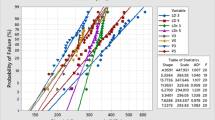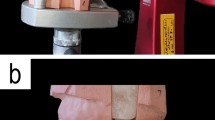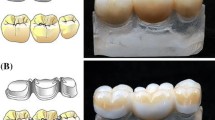Abstract
This study used finite element method to analyze the stress distribution in connector of ceramic-based bilayer structures, in simulation of dental crown-like structures with a functional but weak veneer layer bonded onto a strong core layer. The purpose of this study was to evaluate the stress distribution at veneer/core interface of 2 different core materials [Yttria-stabilized tetragonal zirconia polycrystals (Y-TZP) and lithia disilicate-reinforced glass–ceramic] using three-dimensional finite element analysis. Within the limitations of this study, finite element analysis showed that stress concentrations were located at the veneer/core interface of the connector in Y-TZP core models. The general observation was that compared with Y-TZP, lithia disilicate-reinforced glass–ceramic showed a relatively stable stress value and had a minor effect on the stress concentration susceptibility.
Similar content being viewed by others
Avoid common mistakes on your manuscript.
Introduction
The interest of dentists, dental technicians, and patients in all-ceramic materials is rapidly increasing as stronger and tougher materials are developed and commercialized along with novel processing technologies.
In 1998, Ivoclar released IPS Empress 2, which is a lithia disilicate-reinforced glass–ceramic (LDRGC). IPS Empress 2 is recommended for the fabrication of a 3-unit fixed partial denture (FPD). Strength and fracture toughness values range from 340 to 400 MPa and 2 to 3.3 MPa m1/2, respectively [1]. These observations prompted thinking about differences between LDRGC veneering ceramics, which have been used for over 10 years [2], and the more recently developed veneering ceramics intended for Yttria-stabilized tetragonal zirconia polycrystals (Y-TZP). Recently, clinical studies are now available that support zirconia’s performance potential, with indications of expanded functionality compared with other ceramics, such as use in long span bridges [3]. The primary issues noted in such studies were not related to framework integrity, but rather chipping, wear, and fracture of the veneering ceramics, and fracture can occur in the most vulnerable part of the connector [4]. The veneering ceramics exhibit some compositional and microstructural differences but are manufactured to identical international standards in terms of mechanical properties [5]. Based on clinical observations, the question arises whether zirconia veneers are more susceptible to chipping than LDRGC veneers.
It was reported that the crack propagation of the Y-TZP core FPDs was different from that of lithia disilicate-based FPDs [6]. Moreover, Wakabayashi et al. [7] reported that the thickness ratio of the core to the veneer is the dominant factor that controls the failure initiation site in bilayered ceramic disks with a relatively strong core and weak ceramic veneer. However, relatively little is known about the difference of stress distribution in connector of these two all-ceramic core materials. The aim of this study was to evaluate the stress distribution of two different core materials (Y-TZP and LDRGC) using three-dimensional finite element analysis.
Materials and methods
Figure 1 shows the schematic veneer/core interface designs of connector and boundary conditions used in this study. In order to simulate the connector of the bridge which was like Fig. 1a, the three-dimensional finite element models of connector were constructed (Fig. 1b). Figure 1c showed the section of the connector. All connector dimensions with veneer layer were 5.0 mm, and radius of curvature (r) at embrasure area was 0.9 mm. Diameter of connector core was designed between 0.5 and 4.5 mm at intervals of 0.5 mm.
The meshes of models were created with the use of a three-dimensional 8-node structural solid element (SOLID185; ANSYS). This element is defined by 8 nodes having 3 degrees of freedom at each node: translations in the nodal x, y, and z directions. The finite element models were composed of 15,810 elements.
A simulated vertical load of 100 N was applied at the node at the right lateral side of the veneer surface (Fig. 1c). y-axis displacement of all nodes belonging to the plane of left side was constrained as a boundary condition. Material properties were assumed to be isotropic, homogenous, and linear-elastic. Table 1 showed the material properties which were used in this study. Finite element model construction and finite element analysis were performed on a personal computer (Inspiron 1420, Dell) using a finite element analysis program (ANSYS 10.0, ANSYS). A finite element analysis was used to calculate the principal stress distribution in the connector models.
Results
Stress concentrations were located at the veneer surfaces and veneer/core interfaces of the connector in Y-TZP core models (Fig. 2). Maximum principal stress was calculated by finite element analysis along the center line A-B of connector (Fig. 1c) based on a loading pressure of 100 N (Fig. 3). Y-TZP showed higher tensile stresses occurred near the veneer/core interfaces than that of LDRGC, especially for Fig. 3c–h. When the diameter of the connector core was increased, the stress value of veneer tended to decrease and the stress value of core tended to increase. Compared with Y-TZP, LDRGC showed a relatively stable stress value.
Maximum principal stress calculated by finite element analysis along the center line A–B of connector which was showed in Fig. 1c. The bottom center of the connector was point A. A load of 100 N was applied to the porcelain surface. D diameter of connector core
Discussion
This study used finite element method to analyze the stress distribution in connector of ceramic-based bilayer structures, in simulation of dental crown-like structures with a functional but weak veneer layer bonded onto a strong core layer. Mean masticatory forces have been reported by Anderson [8, 9] to be in the range of 70.6–146.1 N. Thus, the applied 100 N load lies within the range of these values in this study.
Raigrodski et al. [10] reported the connector dimension of first molar and second premolar. The mean hight and width of first molar connector were 4.33–5.63 mm. Oh et al. [11] evaluated the effect of connector design on the fracture resistance of all-ceramic fixed partial dentures. Two wax carvers with radii of curvature at their tips of 0.90 and 0.25 mm were used. The results showed that as the radius at the gingival embrasure increased from 0.25 to 0.90 mm, the mean failure load increased by 140%. Therefore, in this study, we set the dimension of connector with veneer layer to 5 mm and the radius of curvature at embrasure area to 0.9 mm.
Due to the weak interfacial bonding and large fracture toughness difference between the Y-TZP core and the glass veneer, delamination may occur between the two layers easily and the crack go along the interface and then reinitiate at certain stress concentration area of the weaker layer upon further loadings. Janet et al. [12] investigated the chipping resistance of veneered zirconia specimens and compared it to the chipping resistance of porcelain fused to metal specimens and indicated the relationship between chipping and substrate hardness. In this study, under the simulative loading condition, we can find that stress enhancement arising from the differences in elastic modulus between the veneer and the core ceramic was the cause of the interfacial fracture of Y-TZP-based bilayer structures by mechanical analysis. Kelly et al. [13] reported that up to 78% of fractured all-ceramic FPDs with a glass-infiltrated alumina core and porcelain veneer originated at the interface between the core ceramic and veneering porcelain. It was considered that the elastic moduli of alumina core are larger differences to the veneer in elastic modulus.
In a previous study [14] that reported lithia disilicate-based FPD failures from connectors, most of the connector failures were associated with fractures that initiated from occlusal surfaces. In this study, though the LDRGC core layer is tougher than the veneer, the Young’s modulus and Poisson’s ratio are close to the veneer’s; the result shows no obvious differences in the stress distribution of veneer and core for LDRGC models.
Within the limitations of this study, according to the theory of finite element method, this paper gives distribution laws of veneer and core in connector of ceramic-based bilayer structures. Stress analysis further indicated that higher tensile stresses occurred near the veneer/Y-TZP core interfaces than that of lithia disilicate-reinforced glass–ceramic. Dimension of core and veneer would be more influential to the stress distribution for Y-TZP core. Lithia disilicate-reinforced glass–ceramic core had a minor effect on the stress concentration susceptibility.
References
Höland W, Schweiger M, Frank M, Rheinberger V. A comparison of the microstructure and properties of the IPS Empress 2 and the IPS Empress glass–ceramics. J Biomed Mater Res. 2000;53:297–303.
Taskonak B, Sertgöz A. Two-year clinical evaluation of lithia-disilicate-based all-ceramic crowns and fixed partial dentures. Dent Mater. 2006;22:1008–13.
Wolfart S, Eschbach S, Kern M. Outcome of posterior FPDs of veneered zirconia ceramic (Cercon). J Dent Res. 2007;86:0292.
Sailer I, Lüthy H, Feher A, Schumacher M, Schärer P, Hämmerle C. 3-Year results of zirconia posterior fixed partial dentures made by Direct Ceramic Machining (DCM). J Dent Res. 2003;82:0074.
ISO TC 106/SC 2, Dental Ceramic, ISO 6872, 1995.
Taskonak B, Yan J, Mecholsky JJ Jr, Sertgöz A, Koçak A. Fractographic analyses of zirconia-based fixed partial dentures. Dent Mater. 2008;24:1077–82.
Wakabayashi N, Anusavice KJ. Crack initiation modes in bilayered alumina/porcelain disks as a function of core/veneer thickness ratio and supporting substrate stiffness. J Dent Res. 2000;79:1398–404.
Anderson DJ. Measurement of stress in mastication. I. J Dent Res. 1956;35:664–70.
Anderson DJ. Measurement of stress in mastication. II. J Dent Res. 1956;35:671–3.
Raigrodski AJ, Chiche GJ, Potiket N, Hochstedler JL, Mohamed SE, Billiot S, et al. The efficacy of posterior three-unit zirconium-oxide-based ceramic fixed partial dental prostheses: a prospective clinical pilot study. J Prosthet Dent. 2006;96:237–44.
Oh WS, Anusavice KJ. Effect of connector design on the fracture resistance of all-ceramic fixed partial dentures. J Prosthet Dent. 2002;87:536–42.
Quinn JB, Sundar V, Parry EE, Quinn GD. Comparison of edge chipping resistance of PFM and veneered zirconia specimens. Dent Mater. 2010;26:13–20.
Kelly JR, Tesk JA, Sorensen JA. Failure of all-ceramic fixed partial dentures in vitro and in vivo: analysis and modeling. J Dent Res. 1995;74:1253–8.
Taskonak B, Mecholsky JJ, Anusavice KJ. Fracture surface analysis of clinically failed fixed partial dentures. J Dent Res. 2006;85:277–81.
Author information
Authors and Affiliations
Corresponding author
Rights and permissions
About this article
Cite this article
Lin, J., Shinya, A., Gomi, H. et al. Finite element analysis to compare stress distribution of connector of lithia disilicate-reinforced glass–ceramic and zirconia-based fixed partial denture. Odontology 100, 96–99 (2012). https://doi.org/10.1007/s10266-011-0025-2
Received:
Accepted:
Published:
Issue Date:
DOI: https://doi.org/10.1007/s10266-011-0025-2







